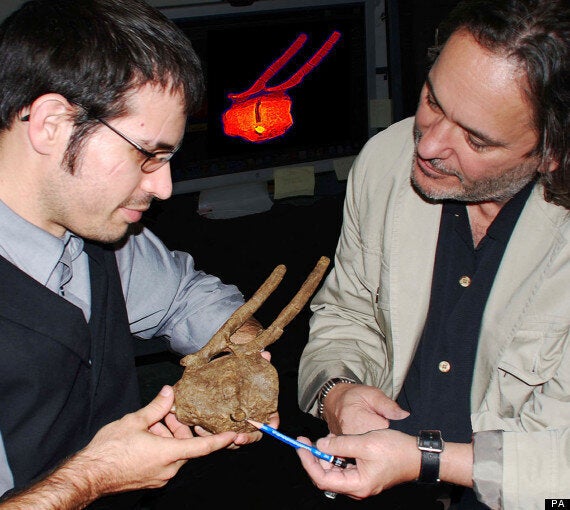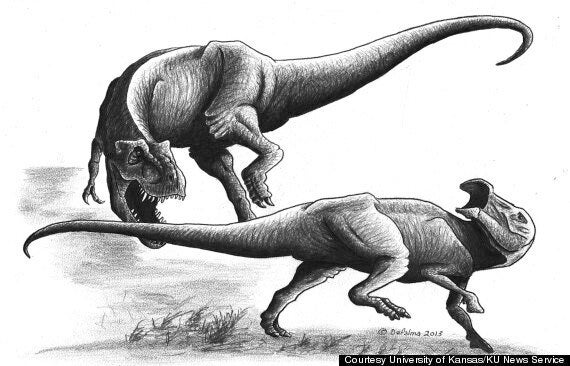A tooth from a Tyrannosaurus rex that bit off more than it could chew proves the creatures were active hunters, scientists have said.
The four centimetre-long crown was left embedded in the tail of plant-eating hadrosaur.
Some 65 million years later, scientists discovered it stuck between two of the hadrosaur's fossilised vertebrae.
Healed bone had grown around the tooth, fusing the vertebrae together, indicating the creature had a lucky escape.
It may have lived for months or even years after almost becoming a T. rex meal.
More importantly for dinosaur experts, the tooth provides strong evidence that the T. rex was actively pursuing living prey.
Opinion is still divided over the dining habits of the fearsome meat-eater, which sported pointed bone-crunching teeth up to nine inches long.
In movies such as Jurassic Park, T. rex is portrayed as a terrifying, merciless hunter.
But some scientists believe in reality it mainly fed on the carcasses of already dead animals, and had more in common with hyenas than lions.
The new discovery from a rock formation known as Hell Creek in South Dakota, US, does not conjure up a picture of a lazy scavenger.
It suggests the hadrosaur was fleeing for its life when the young T.rex's jaws snapped on its tail.

Above: A tooth from a Tyrannosaurus rex that bit off more than it could chew proves the creatures were active hunters, scientists have said.
A US team led by Dr David Burnham, from the University of Kansas, wrote in the journal Proceedings of the National Academy of Sciences:
"The fused vertebrae , and embedded tooth are the result of an attack on a live hadrosaur, not the scavenging of a carcass, and represent unequivocal evidence of a predator-prey relationship.
"We now have conclusive evidence that T. rex indeed engaged in predatory behaviour.
"Whereas previously cited fossil evidence, such as isolated tooth marks, might have been easily misconstrued as the result of scavenging behaviour... our specimen includes the identities of the prey animal, and the attacker, and the fact that the prey was alive when attacked.
"Moreover, the position of the injury - the tail - suggests that T. rex could possibly have engaged in pursuit predation."
The scientists pointed out that the position of the tooth was consistent with present-day pursuit attacks by predators.
African lions had been observed initially targeting the hindquarters of a prey animal in order to immobilise it.

Scientists say the discovery of a tooth in the back of a duckbill dinosaur suggests T. rex hunted live prey.
"This hadrosaur escaped and began to heal around the tooth lodged in its caudal vertebrae, providing evidence of the attack and the identity of the attacker," the researchers added.
"Such evidence is rare in the fossil record for good reason - prey rarely escapes."
It was possible many T. rex bite marks found on other fossils were not associated with bone healing because the prey had been killed, they said.
The fact that the hadrosaur got away did not necessarily mean T. rex was a poor predator, the scientists argued.
Between 45% and 62% of attacks by modern predators such as coyotes and lions ended in failure or were aborted.
The tooth was 3.75 centimetres long and 2.35 centimetres wide at the base and had been broken off at the root.
It was identical in size and shape to teeth from T.rex "sub-adults" housed in museums.
Comparisons with teeth from two other predators strongly suggested the tooth was from T. rex and not some other dinosaur.